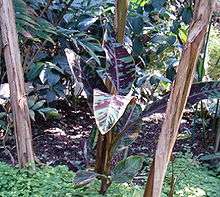Blood banana
| Blood banana | |
|---|---|
 | |
| A typical young specimen | |
| Scientific classification | |
| Kingdom: | Plantae |
| (unranked): | Angiosperms |
| (unranked): | Monocots |
| (unranked): | Commelinids |
| Order: | Zingiberales |
| Family: | Musaceae |
| Genus: | Musa |
| Species: | M. acuminata |
| Variety: | M. a. var. zebrina |
| Trinomial name | |
| Musa acuminata var. zebrina (Van Houtte ex Planch.) Nasution | |
| Synonyms | |
| |
The blood banana (Musa acuminata var. zebrina), is a variety of the wild banana Musa acuminata native to Sumatra, Indonesia. The blood banana is an ornamental plant, named for the dark red patches on its leaves, though its small seeded fruits are also edible.
Taxonomy and nomenclature
The blood banana is a variety of the wild banana species Musa acuminata, one of the two ancestors of modern edible bananas. They were once classified as separate species under the now invalid names (synonyms) Musa zebrina and Musa sumatrana. They were also sometimes incorrectly classified as cultivars.[1]
Blood bananas are also known as the red banana tree though it should not be confused with the red banana cultivar. Other common names in English include seeded red banana, Sumatra ornamental banana, and maroon-variegated banana plant. They are also known as banano rojo in Spanish, ゼブリナバナナ (zeburina banana) in Japanese, กล้วยมะนี (kluai ma ni) in Thai, and chuối kiểng in Vietnamese.[2]
Description
Blood bananas are characterized by dark red patches of variable sizes on their dark green leaves. Their pseudostems are characteristically very slender. They bear small slender fruits filled with grape-like seeds.[3]
Distribution
Blood bananas are native to Java, Indonesia. They are notable for being one of the earliest banana subspecies to be spread by humans out of Southeast Asia. Introduced eastward to Africa, it became the ancestors for the genetically distinct and commercially important East African Highland bananas (Mutika/Lujugira subgroup of the AAA group).[3]
It is probably the only seeded banana to ever be introduced into Hawaii before European contact. It is known as the Mai'a 'Oa in Hawaiian, though the name is also applied to the species Musa balbisiana which was introduced later on.[3]
Gallery
 Essentially unpatterned young plant at Longwood Gardens
Essentially unpatterned young plant at Longwood Gardens.jpg) Closeup of a strongly patterned leaf
Closeup of a strongly patterned leaf
See also
References
- ↑ "Musa acuminata Colla var. zebrina (Van Houtte ex Planch.) Nasution". Germplasm Resources Information Network (GRIN). Agricultural Research Service (ARS), United States Department of Agriculture (USDA). Retrieved June 28, 2011.
- ↑ Michel H. Porcher (March 22, 2011). "Sorting Musa names". The University of Melbourne. Retrieved June 28, 2011.
- 1 2 3 Randy C. Ploetz; Angela Kay Kepler; Jeff Daniells & Scot C. Nelson (2007). "Banana and plantain — an overview with emphasis on the Pacific island cultivars" (PDF). Species Profiles for Pacific Island Agroforestry. Traditional Tree Initiative. Retrieved June 5, 2011.
